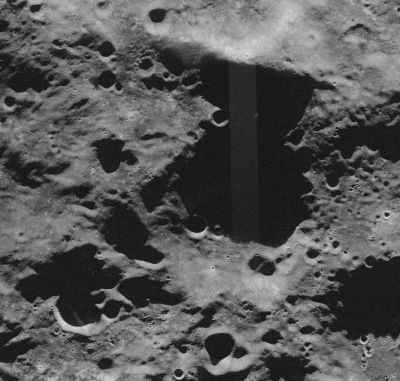Difference between revisions of "Haworth"
(Created page with "<div id="content_view" class="wiki" style="display: block"> =Haworth= <div id="toc"> =Table of Contents= <div style="margin-left: 1em">[#Haworth Haworth]</div><div style="...") |
|||
| Line 8: | Line 8: | ||
Lat: 86.9°S, Long: 4.0°W, Diameter: 35 km, Depth: , [/R%C3%BCkl%2073 Rükl 73]<br /> | Lat: 86.9°S, Long: 4.0°W, Diameter: 35 km, Depth: , [/R%C3%BCkl%2073 Rükl 73]<br /> | ||
|} | |} | ||
| − | [[Image:normal_Haworth_CampbellRadar_12_6cm_20m.jpg|external image normal_Haworth_CampbellRadar_12_6cm_20m.jpg]]<br /> ''[http://lpod.org/coppermine/displayimage.php?pos=-3861 Donald and Bruce Campbell]'' '''Haworth''' is the prominent pentagonal crater near the center of this field cropped from a stereographic projection of the Moon's south polar area "photographed" with 12.6 cm radar pulses. The direction towards Earth is at the top. The ridge above '''Haworth''' is unofficially known as '''Malapert Alpha''' (a [http://the-moon. | + | [[Image:normal_Haworth_CampbellRadar_12_6cm_20m.jpg|external image normal_Haworth_CampbellRadar_12_6cm_20m.jpg]]<br /> ''[http://lpod.org/coppermine/displayimage.php?pos=-3861 Donald and Bruce Campbell]'' '''Haworth''' is the prominent pentagonal crater near the center of this field cropped from a stereographic projection of the Moon's south polar area "photographed" with 12.6 cm radar pulses. The direction towards Earth is at the top. The ridge above '''Haworth''' is unofficially known as '''Malapert Alpha''' (a [http://the-moon.us/wiki/Lunar%20Mons discontinued] IAU name). [/Shoemaker Shoemaker] is partially visible in the lower right. What look like shadows are areas that were not visible from Earth, and hence for which no data were collected. None of the other features in this field have IAU-approved names.<br /> <br /> |
==Images== | ==Images== | ||
[http://www.lpod.org/coppermine/thumbnails.php?album=search&type=full&search=Haworth LPOD Photo Gallery] [http://www.lpi.usra.edu/resources/lunar_orbiter/bin/srch_nam.shtml?Malapert%7C0 Lunar Orbiter Images]<br /> <br /> | [http://www.lpod.org/coppermine/thumbnails.php?album=search&type=full&search=Haworth LPOD Photo Gallery] [http://www.lpi.usra.edu/resources/lunar_orbiter/bin/srch_nam.shtml?Malapert%7C0 Lunar Orbiter Images]<br /> <br /> | ||
| Line 14: | Line 14: | ||
''([/LAC%20zone LAC zone] 144C2)'' [http://planetarynames.wr.usgs.gov/images/Lunar/lac_144.pdf USGS Digital Atlas PDF]<br /> <br /> | ''([/LAC%20zone LAC zone] 144C2)'' [http://planetarynames.wr.usgs.gov/images/Lunar/lac_144.pdf USGS Digital Atlas PDF]<br /> <br /> | ||
==Description== | ==Description== | ||
| − | '''Haworth''' is the prominent 35-km diameter pentagonal crater seen just beyond [/Malapert Malapert Alpha] in radar maps of the lunar south pole (to the upper left of "Sh" = [/Shoemaker Shoemaker] in [http:// | + | '''Haworth''' is the prominent 35-km diameter pentagonal crater seen just beyond [/Malapert Malapert Alpha] in radar maps of the lunar south pole (to the upper left of "Sh" = [/Shoemaker Shoemaker] in [http://www2.lpod.org/wiki/November_7,_2006 this one], for example). Since the radar can see it, it must, in theory, be visible from Earth, but because it is in nearly permanent shadow it is rarely, if ever, obvious -- even in photographs taken from space. We know of its existence because radar beams from Earth can occasionally reach into it at a steeper angle than sunlight can. <span class="membersnap">- [http://www.wikispaces.com/user/view/JimMosher [[Image:JimMosher-lg.jpg|16px|JimMosher]]] [http://www.wikispaces.com/user/view/JimMosher JimMosher]</span><br /> <br /> |
==Wikipedia== | ==Wikipedia== | ||
[https://en.wikipedia.org/wiki/Haworth_(crater) Haworth]<br /> <br /> | [https://en.wikipedia.org/wiki/Haworth_(crater) Haworth]<br /> <br /> | ||
Revision as of 20:16, 11 April 2018
Contents
Haworth
Table of Contents
|
Lat: 86.9°S, Long: 4.0°W, Diameter: 35 km, Depth: , [/R%C3%BCkl%2073 Rükl 73] |

Donald and Bruce Campbell Haworth is the prominent pentagonal crater near the center of this field cropped from a stereographic projection of the Moon's south polar area "photographed" with 12.6 cm radar pulses. The direction towards Earth is at the top. The ridge above Haworth is unofficially known as Malapert Alpha (a discontinued IAU name). [/Shoemaker Shoemaker] is partially visible in the lower right. What look like shadows are areas that were not visible from Earth, and hence for which no data were collected. None of the other features in this field have IAU-approved names.
Images
LPOD Photo Gallery Lunar Orbiter Images
Maps
([/LAC%20zone LAC zone] 144C2) USGS Digital Atlas PDF
Description
Haworth is the prominent 35-km diameter pentagonal crater seen just beyond [/Malapert Malapert Alpha] in radar maps of the lunar south pole (to the upper left of "Sh" = [/Shoemaker Shoemaker] in this one, for example). Since the radar can see it, it must, in theory, be visible from Earth, but because it is in nearly permanent shadow it is rarely, if ever, obvious -- even in photographs taken from space. We know of its existence because radar beams from Earth can occasionally reach into it at a steeper angle than sunlight can. - JimMosher JimMosher
Wikipedia
Additional Information
- IAU page Haworth
Nomenclature
- Named for Walter Haworth (March 19, 1883 – March 19, 1950), a British chemist who is best known for his groundbreaking work on ascorbic acid (vitamin C). He received the 1937 Nobel Prize in Chemistry. The "Ha" is apparently pronounced as in "hawk", but separated from the "w".
- The name Haworth was officially approved in October 2008.
LPOD Articles
Bibliography
Two New Crater Names Approved for Earth's Moon
This page has been edited 1 times. The last modification was made by - tychocrater tychocrater on Jun 13, 2009 3:24 pm - mfx3